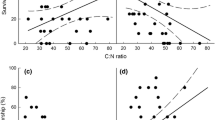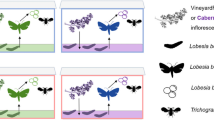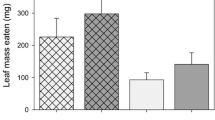Abstract
Predicted increases in atmospheric CO2 and global mean temperature may alter important plant-insect associations due to the direct effects of temperature on insect development and the indirect effects of elevated temperature and CO2 enrichment on phytochemicals important for insect success. We investigated the effects of CO2 and temperature on the interaction between gypsy moth (Lymantria dispar L.) larvae and red maple (Acer rubrum L.) saplings by bagging first instar larvae within open-top chambers at four CO2/temperature treatments: (1) ambient temperature, ambient CO2, (2) ambient temperature, elevated CO2 (+300 μl l-1 CO2), (3) elevated temperature (+3.5°C), ambient CO2, and (4) elevated temperature, elevated CO2. Larvae were reared to pupation and leaf samples taken biweekly to determine levels of total N, water, non-structural carbohydrates, and an estimate of defensive phenolic compounds in three age classes of foliage: (1) immature, (2) mid-mature and (3) mature. Elevated growth temperature marginally reduced (P <0.1) leaf N and significantly reduced (P <0.05) leaf water across CO2 treatments in mature leaves, whereas leaves grown at elevated CO2 concentration had a significant decrease in leaf N and a significant increase in the ratio of starch:N and total non-structural carbohydrates:N. Leaf N and water decreased and starch:N and total non-structural carbohydrates:N ratios increased as leaves aged. Phenolics were unaffected by CO2 or temperature treatment. There were no interactive effects of CO2 and temperature on any phytochemical measure. Gypsy moth larvae reached pupation earlier at the elevated temperature (female =8 days, P <0.07; male =7.5 days, P <0.03), whereas mortality and pupal fresh weight of insects were unrelated to either CO2, temperature or their interaction. Our data show that CO2 or temperature-induced alterations in leaf constituents had no effect on insect performance; instead, the long-term exposure to a 3.5°C increase in temperature shortened insect development but had no effect on pupal weight. It appears that in some tree-herbivorous insect systems the direct effects of an increased global mean temperature may have greater consequences for altering plant-insect interactions than the indirect effects of an increased temperature or CO2 concentration on leaf constituents.




Similar content being viewed by others
References
Appel HM, Governor HL, D'Ascenzo M, Siska E, Schultz JC (2001) Limitations of folin assays of foliar phenolics in ecological studies. J Chem Ecol 27:761–778
Bale JS, Masters GJ, Hodkinson ID, Awmack C, Bezemer MT, Brown V, Butterflield J, Buse A, Coulson JC, Farrar J, Good, JED, Harrington R, Hartley S, Jones TH, Lindroth RL, Press MC, Symrnioudis I, Watt A, Whittaker JB (2002) Herbivory in global climate change research: direct effects of rising temperature on insect herbivores. Global Change Biol 8:1–16
Bezemer TM, Jones TH, Knight KJ (1998) Long-term effects of elevated CO2 and temperature on populations of the peach potato aphid Myzus persicae and its parasitoid Aphidius matricariae. Oecologia 116:128–135
Booker FL, Maier CA (2001) Atmospheric carbon dioxide, irrigation, and fertilization effects on phenolic and nitrogen concentrations in loblolly pine (Pinus taeda) needles. Tree Physiol 21:609–616
Buse A, Good JED, Dury S, Perrins CM (1998) Effects of elevated temperature and carbon dioxide on the nutritional quality of leaves of oak (Quercus robur L.) as food for the winter moth (Operophtera brumata L.). Funct Ecol 12:742–749
Casagrande RA (1981) Larval and pupal development of the gypsy moth. In: Doane CC, McMannus ML (eds) The gyspy moth: research towards integrated pest management. USDA Technical Research Bulletin 1584, USDA, Washington, D.C., pp 154–160
Casey TM (1993) Effects of temperature on foraging of caterpillars. In: Stamp NE, Casey TM (eds) Caterpillars: ecological and evolutionary constraints on foraging. Chapman and Hall, New York, pp 5–28
Clancy KM, Price PW (1987) Rapid herbivore growth enhances enemy attack: sublethal plant defenses remain a paradox. Ecology 68:733–737
Cotrufo MF, Ineson P, Scott A (1998) Elevated CO2 reduces the nitrogen concentration of plant tissues. Global Change Biol 4:43–54
Coviella CE, Trumble JT (1999) Effects of elevated atmospheric carbon dioxide on insect-plant interactions. Conserv Biol 13:700–712
Curtis PS, Wang X (1998) A meta-analysis of elevated CO2 effects on woody plant mass, form, and physiology. Oecologia 113:299–313
Dury SJ, Good JEG, Perrins CM, Buse A, Kaye T (1998) The effects of increasing CO2 and temperature on oak leaf palatability and the implications for herbivorous insects. Global Change Biol 4:55–61
Edwards NT, Norby RJ (1999) Below-ground respiratory responses of sugar maple and red maple saplings to atmospheric CO2 enrichment and elevated air temperature. Plant Soil 206:85–97
Hansen RW (1988) Behavioral competitiveness of F1-sterile gypsy moth larvae under field conditions. Otis Methods Development Center, report GM 86.2.5a, Otis ANGB, Massachusetts, pp 173–190
Houghton JT, Meiro Filho LG, Callander BA, Harris N, Kattenberg A, Makell K (eds) (1996) Climate change 1995: the science of climate change. Contribution of working group I to the second assessment of the intergovernmental panel on climate change. Cambridge University Press, Cambridge
Johns CV, Hughes L (2002) Interactive effects of elevated CO2 and temperature on the leaf-miner Dialectica scalariella Zeller (Lepidoptera:Gracillariidae) in Paterson's Curse, Echium plantagineum (Boraginaceae). Global Change Biol 8:142–152
Kerstiens G (2001) Meta-analysis of the interaction between shade-tolerance, light environment and growth response of woody species to elevated CO2. Acta Oecol 22:61–69
Kinney KK, Lindroth RL, Jung SM, Nordheim EV (1997) Effects of CO2 and NO3 availability on deciduous trees: phytochemistry and insect performance. Ecology 78:215–230
Lincoln DE, Fajer ED, Johnson RH (1993) Plant-insect herbivore interactions in elevated CO2 environments. Trends Ecol Evol 8:64–68
Lindroth RL, Kinney KK, Platz CL (1993) Responses of deciduous trees to elevated atmospheric CO2: productivity, phytochemistry, and insect performance. Ecology 74:763–777
Lindroth RL, Klein KA, Hemming JDC, Feuker AM (1997a) Variation in temperature and dietary nitrogen affect performance of the gypsy moth (Lymantria dispar). Physiol Entomol 22:55–64
Lindroth RL, Roth S, Kruger EL, Volin JC, Koss PA (1997b) CO2-mediated changes in aspen chemistry: effects on gypsy moth performance and susceptibility to virus. Global Change Biol 3:279–289
Mastro VC (1993) Gypsy moth F1 sterility programme: current status. In: Radiation induced F1 sterility in Lepidoptera for area-wide control. International Atomic Energy Agency, Vienna, pp 125–129
Mattson JW (1980) Nitrogen and herbivory. Annu Rev Ecol Syst 11:119–162
Mattson JW, Addy ND (1975) Phytophagous insects as regulators of forest primary productivity. Science 190:515–522
Mole S, Waterman PG (1987) A critical analysis of techniques for measuring tannins in ecological studies. I. Techniques for chemically defining tannins. Oecologia 72:137–147
Morison JIL, Lawlor DW (1999) Interactions between increasing CO2 concentration and temperature on plant growth. Plant Cell Environ 22:659–682
Norby RJ, Edwards NT, Riggs JS, Abner CH, Wullschleger SD, Gunderson CA (1997) Temperature-controlled open-top chambers for global change research. Global Change Biol 3:259–267
Norby RJ, Wullschleger SD, Gunderson CA, Johnson DW, Ceulemans R (1999) Tree responses to rising CO2 in field experiments: implications for the future forest. Plant Cell Environ 22:683–714
Norby RJ, Long TM, Hartz-Rubin JS, O'Neill EG (2000) Nitrogen resorption in senescing tree leaves in a warmer, CO2-enriched atmosphere. Plant Soil 224:15–29
Raupp MJ, Denno RF (1983) Leaf age as a predictor of herbivore distribution and abundance. In: Denno RF, McClure MS (eds) Variable plants and herbivores in natural and managed systems. Academic Press, New York, pp 91–124
Roth SK, Lindroth RL (1994) Effects of CO2-mediated changes in paper birch and white pine chemistry on gypsy moth performance. Oecologia 98:133–138
Roth SK, Lindroth RL (1995) Elevated atmospheric CO2 effects on phytochemistry, insect performance and insect-parasitoid interactions. Global Change Biol 1:173–182
Roth SK, Lindroth RL, Volin JC, Kruger EL (1998) Enriched atmospheric CO2 and defoliation: effects on tree chemistry and insect performance. Global Change Biol 4:419–430
SAS Institute (1996) SAS for Power PC, version 6.12. SAS Institute, Cary, N.C.
Schowalter TD, Hargrove WW, Crossley DA (1986) Herbivory in forested ecosystems. Annu Rev Entomol 31:177–196
Schwalbe CP, Mastro VC, Hansen RW (1991) Prospects for genetic control of the gypsy moth. For Ecol Manage 39:163–171
Scriber JM, Slansky F Jr (1981) The nutritional ecology of immature insects. Ann Rev Entomol 26:183–211
Singleton VL, Rossi JA (1965) Colorimetry of total phenolics with phosphomolybdic-phosphotungstic acid reagents. Am J Enol Viti 16:144–158
Slansky F Jr (1993) Nutritional ecology: the fundamental quest for nutrients. In: Stamp NE, Casey TM (eds) Caterpillars: ecological and evolutionary constraints on foraging. Chapman and Hall, New York, pp 29–91
Stamp NE (1990) Growth versus molting time of caterpillars as a function of temperature, nutrient concentration and the phenolic rutin. Oecologia 82:107–113
Stamp NE, Yang Y (1996) Response of insect herbivores to multiple allelochemicals under different thermal regimes. Ecology 77:1088–1102
Strom BL, Hain FP, Ayers MP (1996) Field performance of F1-sterile gypsy moth larvae (Lepidoptera: Lymantriidae) on loblolly pine and sweetgum. Environ Entomol 25:749–756
Taylor F (1981) Ecology and evolution of physiological time in insects. Am Nat 117:1–23
Thornley HM, Cannell MGR (1996) Temperate forest responses to carbon dioxide, temperature and nitrogen: a model analysis. Plant Cell Environ 19:1331–1348
Tissue DT, Wright SJ (1995) Effect of seasonal water availability on phenology and the annual shoot carbohydrate cycle of tropical forest shrubs. Funct Ecol 9:518–527
Tissue DT, Thomas RB, Strain BR (1997) Atmospheric CO2 enrichment increases growth and photosynthesis of Pinus taeda: a 4-year experiment in the field. Plant Cell Environ 20:1123–1134
Traw MB, Lindroth RL, Bazzaz FA (1996) Decline in gypsy moth (Lymantria dispar) performance in an elevated CO2 atmosphere depends upon host plant species. Oecologia 108:113–120
Watt AD, Whittaker JB, Docherty M, Brooks G, Lindsay E, Salt DT (1995) The impact of elevated atmospheric CO2 on insect herbivores. In: Harrington R, Stork NE (eds) Insects and a changing environment. Academic Press, London, pp 197–217
Williams RS, Lincoln DE, Thomas RB (1994) Loblolly pine grown under elevated CO2 affects early instar pine sawfly performance. Oecologia 98:64–71
Williams RS, Lincoln DE, Norby RJ (1998) Leaf age effects of elevated CO2-grown white oak leaves on spring-feeding lepidopterans. Global Change Biol 4:235–246
Williams RS, Norby RJ, Lincoln DE (2000) Effects of elevated CO2 and temperature-grown red and sugar maple on gypsy moth performance. Global Change Biol 6:685–696
Acknowledgements
Special thanks go to Trey Franklin for his work on the phytochemical analyses and to Vic Mastro at USDA-APHIS for his assistance in obtaining gypsy moth egg masses. Members of the Environmental Sciences Division at ORNL contributed valuable time and effort to this project. We gratefully acknowledge the helpful comments and suggestions of anonymous reviewers and Ms. Beverly Moser. Advice on the statistical analysis from Dr. Howard Neufeld, Department of Biology, Appalachian State University, and Dr. Greg Somers, Auburn University, was greatly appreciated. This work was supported by a grant from the National Institute of Global Environmental Change to D.E. Lincoln (UA/96UOSC12) and the U.S. Department of Energy's Office of Biological and Environmental Research and Office of Science. This research was performed at the Oak Ridge National Laboratory, which is managed by UT-Battelle, LLC, for the U.S. Department of Energy under contract DE-0AC05–00OR22725. This work contributes to the Global Change and Terrestrial Ecosystems Core Research Programme, a core project of the International Geosphere-Biosphere Programme.
Author information
Authors and Affiliations
Corresponding author
Rights and permissions
About this article
Cite this article
Williams, R.S., Lincoln, D.E. & Norby, R.J. Development of gypsy moth larvae feeding on red maple saplings at elevated CO2 and temperature. Oecologia 137, 114–122 (2003). https://doi.org/10.1007/s00442-003-1327-z
Received:
Accepted:
Published:
Issue Date:
DOI: https://doi.org/10.1007/s00442-003-1327-z




